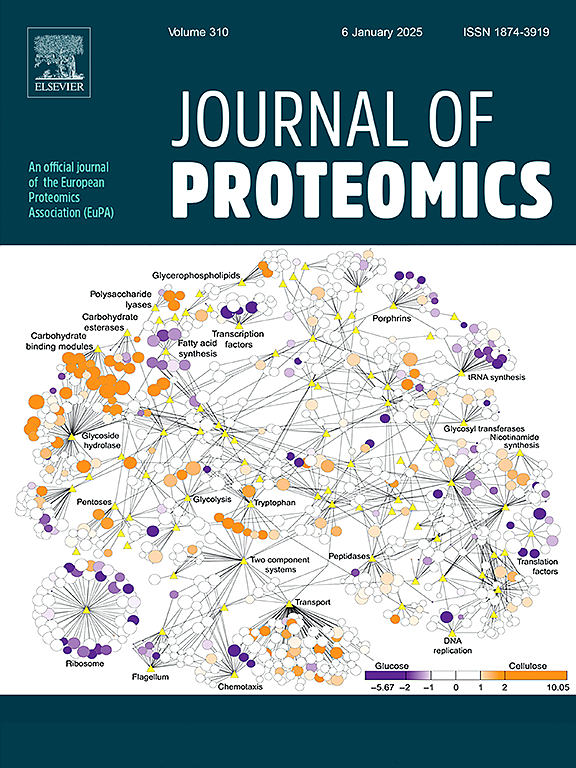Quantitative proteomic analysis of the Toxoplasma gondii cytoskeleton and bioinformatic identification of highly antigenic proteins
IF 2.8
2区 生物学
Q2 BIOCHEMICAL RESEARCH METHODS
引用次数: 0
Abstract
The Toxoplasma gondii cytoskeleton is a highly organized structure essential for parasite motility, replication, and host cell invasion. To identify its components, a highly enriched fraction of tachyzoite cytoskeletons was obtained and quantitatively analyzed by mass spectrometry. We identified 623 proteins classified into 18 functional groups, including 30 IMC proteins, 34 cytoskeleton proteins, and 14 uncharacterized proteins. A comprehensive bioinformatic analysis was conducted to assess protein abundance (fmol), antigenicity, accessibility, interactome, and homology, with the aim of identifying immunogenic targets. Among the top vaccine candidates were -GRA12, IMC1, ROP8, and -IMC4, with ROP8 emerging as the most promising based on epitope prediction. Data are available via ProteomeXchange with identifier PXD063409.
Significance
Toxoplasma gondii represents one of the most virulent and successful parasites in human and veterinary pathogenesis. Since T. gondii is a highly dynamic parasite that depends on its cytoskeleton to invade and disseminate through tissues, knowledge of its cytoskeleton composition is essential for understanding the biological mechanisms involved in parasite-host interactions and for the design of pharmaceutical and vaccination strategies. Quantitative proteomic analysis of the T. gondii cytoskeleton provided new and extensive information on its composition and, through bioinformatics approaches, allowed us to suggest several candidate molecules for future immunoprotective design.

刚地弓形虫细胞骨架定量蛋白质组学分析及高抗原蛋白的生物信息学鉴定
刚地弓形虫细胞骨架是一种高度组织化的结构,对寄生虫的运动、复制和宿主细胞入侵至关重要。为了鉴定其成分,获得了高富集的速殖子细胞骨架,并用质谱法对其进行了定量分析。我们鉴定了623个蛋白质,分为18个功能基团,包括30个IMC蛋白,34个细胞骨架蛋白和14个未表征蛋白。为了确定免疫原性靶点,进行了全面的生物信息学分析,以评估蛋白质丰度(fmol)、抗原性、可及性、相互作用组和同源性。最热门的候选疫苗包括-GRA12、IMC1、ROP8和-IMC4,基于表位预测,ROP8是最有希望的。数据可通过ProteomeXchange获得,标识符为PXD063409。刚地弓形虫是人类和兽医致病机制中最致命和最成功的寄生虫之一。由于弓形虫是一种高度动态的寄生虫,依靠其细胞骨架在组织中入侵和传播,因此了解其细胞骨架组成对于理解寄生虫-宿主相互作用的生物学机制以及设计药物和疫苗接种策略至关重要。弓形虫细胞骨架的定量蛋白质组学分析为其组成提供了新的和广泛的信息,并通过生物信息学方法,使我们能够为未来的免疫保护设计提出几个候选分子。
本文章由计算机程序翻译,如有差异,请以英文原文为准。
求助全文
约1分钟内获得全文
求助全文
来源期刊

Journal of proteomics
生物-生化研究方法
CiteScore
7.10
自引率
3.00%
发文量
227
审稿时长
73 days
期刊介绍:
Journal of Proteomics is aimed at protein scientists and analytical chemists in the field of proteomics, biomarker discovery, protein analytics, plant proteomics, microbial and animal proteomics, human studies, tissue imaging by mass spectrometry, non-conventional and non-model organism proteomics, and protein bioinformatics. The journal welcomes papers in new and upcoming areas such as metabolomics, genomics, systems biology, toxicogenomics, pharmacoproteomics.
Journal of Proteomics unifies both fundamental scientists and clinicians, and includes translational research. Suggestions for reviews, webinars and thematic issues are welcome.
 求助内容:
求助内容: 应助结果提醒方式:
应助结果提醒方式:


